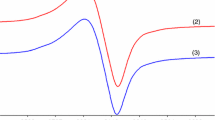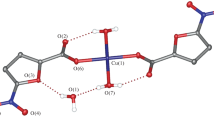Abstract
Four coordination compounds of copper(II) were synthesised and characterised in solid state by elemental analysis, infrared, electronic and EPR spectroscopy, as well as by thermal analysis (TG/DTA). The complexes were formulated on the basis of experimental data as: [Cu(BzIm)2(H2O)]·H2O (1), [Cu2(Acr)4(HBzIm)2] (2), [Cu(Acr)2(HBzIm)2] (3) and [Cu(Acr)2(HBzIm)2(H2O)]·H2O (4). IR data are in accordance with the unidentate nature of benzimidazole, in complexes (2), (3) and (4), and bridge bidentate nature of benzimidazole, in complex (1), while acrylato acts as uni- or bridge/chelate ligand. The electronic spectra display the characteristic pattern of square planar, square pyramidal, or octahedral stereochemistry, also confirmed by EPR spectra. Thermal decomposition evidenced several well-defined steps as dehydration of complexes (1) and (4), benzimidazole molecule releases for all complexes and acrylate decomposition in carbonate for complexes (3) and (4). In all four cases, the final residue after thermal treatment in air flow is copper(II) oxide, formed during the decomposition steps for complexes (3) and (4), and, respectively, after the oxidation of the metallic copper for complexes (1) and (2). Antimicrobial activities of the complexes have been determined by in vitro assays, against various Gram-negative and Gram-positive bacterial and fungal strains. Copper(II) complexes were also evaluated for their cytotoxicity on eukaryotic cells.












Similar content being viewed by others
References
Arjmand F, Mohani B, Ahmad S. Synthesis, antibacterial, antifungal activity and interaction of CT-DNA with a new benzimidazole derived Cu(II) complex. Eur J Med Chem. 2005;40:1103–10.
Mishra L, Yadaw AK. Exploring new bioactive Ru(lI) polypyridyl complexes through their interaction with DNA. J Indian Chem. 2000;39A:660–3.
Naik AD, Annigeri SM, Gangadharmath UB, Revankar VK, Mahale VB. Anchoring mercapto-triazoles on dicarbonyl backbone to assemble novel binucleating, acyclic SNONS compartmental ligands. Indian J. Chem. 2002;24A:2046–53.
Seela F, Wenzel T. Oligodeoxyribonucleotides containing 4-aminobenzimidazole in place of adenine: solid-phase synthesis and base pairing. Helv Chim Acta. 1995;78:833–46.
Moreno MJS, Botello AF, Coca RBG, Griesser R, Ochocki J, Kotynski A, Gutierrez JN, Moreno V, Sigel H. Metal ion-binding properties of (1H-benzimidazol-2-yl-methyl)phosphonate (Bimp2−) in aqueous solution. Isomeric equilibria, extent of chelation, and a new quantification method for the chelate effect. Inorg Chem. 2004;43:1311–22.
Téllez F, López-Sandoval H, Castillo-Blum SE, Barba-Behrens N. Coordination behavior of benzimidazole, 2-substituted benzimidazoles and benzothiazoles, towards transition metal ions. ARKIVOC. 2008;v:245-75.
Drolet DP, Manuta DM, Lees AJ, Katnani AD, Coyle GJ. FT-IR and XPS study of copper(II) complexes of imidazole and benzimidazole. Inorg Chim Acta. 1988;146:173–80.
Pashchevskaya NV, Nazarenko MA, Bolotin SN, Oflidi AI, Panyushkin VT. Effect of the condition of synthesis on the composition and structure of copper(II) complexes with benzimidazole. Russ J Inorg Chem. 2010;9(55):1510–7.
Qin L, Liu L-W, Du X, Cui G-H. Two dinuclear copper(II) complexes based on 5,6-dimethylbenzimidazole ligands: synthesis, crystal structures, and catalytic properties. Transition Met Chem. 2013;38:85–91.
Yurdakul Ş, Kurt M. Vibrational spectroscopic studies of metal(II) halide benzimidazole. J Mol Struct. 2003;650:181–90.
Machura B, Świtlicka A, Wolff M, Kusz J, Kruszynski R. Synthesis, spectroscopic characterization, X-ray structure and DFT calculations of copper(II) complex with 2-(2-pyridyl)benzimidazole. Polyhedron. 2009;28:1348–54.
Tadokoro M, Nakasuji K. Hydrogen bonded 2,2′-biimidazolate transition metal complexes as a tool of crystal engineering. Coord Chem Rev. 2000;198:205–18.
Sunatsuki Y, Motoda Y, Matsumoto N. Copper(II) complexes with multidentate Schiff-base ligands containing imidazole groups: ligand-complex or self-complementary molecule? Coord Chem Rev. 2002;226:199–209.
Rowan R, Tallon T, Sheahan AM, Curran R, McCann M, Devereux M, Kavanagh K, McKee V. ‘Silver bullets’ in antimicrobial chemotherapy: synthesis, characterisation and biological screening of some new Ag(I)-containing imidazole complexes. Polyhedron. 2006;25:1771–8.
Fu Y-M, Zhao Y-H, Lan Y-Q, Wang Y, Qiu Y-Q, Shao K-Z, Su Z-M. A chiral 3D polymer with right- and left-helices based on 2,2′-biimidazole: synthesis, crystal structure and fluorescent property. Inorg Chem Commun. 2007;10:720–3.
Higa T, Moriya M, Shimazaki Y, Yajima T, Tani F, Karasawa S, Nakano M, Naruta Y, Yamauchi O. Synthesis and characterization of imidazolate-bridged polynuclear copper complexes. Inorg Chim Acta. 2007;360:3304–13.
Deschamps P, Kulkarni PP, Gautam-Basak M, Sarkar B. The saga of copper(II)–l-histidine. Coord Chem Rev. 2005;249:895–909.
Szilágyi O, Ősz K, Várnagy K, Sanna D, Süli-Vargha H, Sóvágó I, Micera G. Potentiometric and spectroscopic studies on the copper(II) and zinc(II) complexes of bis(imidazol-2-yl) derivatives of tripeptides. Polyhedron. 2006;25:3173–82.
Várnagy K, Sóvágó I, Süli-Vargha H, Sanna D, Micera G. The effect of histidyl residues on the complexation of bis (imidazolyl) containing tripeptides with copper (II) ion. J Inorg Biochem. 2000;81:35–41.
Török I, Surdy P, Rockenbauer A, Korecz L Jr, Koolhaas GJAA, Gajda T. Nickel(II)-, copper(II)- and zinc(II) complexes of some substituted imidazole ligands. J Inorg Biochem. 1998;71:7–14.
Ősz K, Várnagy K, Süli-Vargha H, Csámpay A, Sanna D, Micera G, Sóvágó I. Acid-base properties and copper(II) complexes of dipeptides containing histidine and additional chelating bis(imidazol-2-yl) residues. J Inorg Biochem. 2004;98:24–32.
Hinge VK, Joshi SK, Shrivastava BD, Prasad J, Srivatsava K. X-ray absorption studies of copper(II) mixed ligand complexes with benzimidazole as one of the ligands. Indian J Pure Appl Phys. 2011;49:168–72.
Materazzi S, Curini R, D’Ascenzo G. Thermoanalytical behaviour of histidine complexes with transition metal ions. Thermochim Acta. 1996;275:93–108.
Materazzi S, Curini R, D’Ascenzo G. Thermoanalytical study of benzimidazole complexes with transition metal ions: copper (II) complexes. Thermochim Acta. 1996;286:1–15.
Vlaicu ID, Constand M, Olar R, Marinescu D, Grecu MN, Lazar V, Chifiriuc MC, Badea M. Thermal stability of new biologic active copper(II) complexes with 5,6-dimethylbenzimidazole. J Therm Anal Calorim. 2013;113:1369–77.
Mrozinski J, Heyduk E. Binuclear copper (II) complexes with α,β-unsaturated carboxylic acids. Part I. Copper acrylates with heterocyclic amine adducts. Pol J Chem. 1982;56:683–9.
Saviuc C, Grumezescu AM, Holban A, Bleotu C, Chifiriuc C, Balaure P, Lazar V. Phenotypical studies of raw and nanosystem embedded Eugenia caryophyllata buds essential oil antibacterial activity on Pseudomonas aeruginosa and Staphylococcus aureus strains. Biointerface Res Appl Chem. 2011;1:111–8.
Olar R, Badea M, Marinescu D, Chifiriuc C, Bleotu C, Grecu N, Iorgulescu EE, Bucur M, Lazar V, Finaru A. Prospects for new antimicrobials based on N,N-dimethylbiguanide complexes as effective agents on both planktonic and adherent microbial strains. Eur J Med Chem. 2010;45:2868–75.
Darzynkiewicz Z. Nucleic acid analysis. In: Robinson JP, editor. Current protocols in cytometry. New York: Wiley; 1997.
Deacon GB, Philips JR. Relationships between the carbon-oxygen stretching frequencies of carboxylato complexes and the type of carboxylate coordination. Coord Chem Rev. 1980;33:227–50.
Nakamoto K. Infrared and Raman spectra of inorganic and coordination compounds. New York: Wiley; 1986.
Lever ABP. Inorganic electronic spectroscopy. Amsterdam: Elsevier; 1986.
Hathaway BJ, Billing DE. The electronic properties and stereochemistry of mono-nuclear complexes of the copper(II) ion. Coord Chem Rev. 1970;5:143–207.
Hathaway BJ. A new look at the stereochemistry and electronic properties of complexes of the copper(II) ion. Struct Bond. 1984;57:55–118.
Doumit J, McPherson GL, Belford RL, Lanoux SB, Jonassen HB. Preparation and properties of copper(II) complexes of 2,2'-dicarboxyazobenzene. A new series of copper acetate like dimers. Inorg Chem. 1977;16:565–9.
Badea M, Olar R, Marinescu D, Segal E, Rotaru A. Thermal stability of some new complexes bearing ligands with polymerizable groups. J Therm Anal Calorim. 2007;88:317–21.
Gaber M, El-Hefnawy GB, El-Borai MA, Mohamed NF. Synthesis, spectral and thermal studies of Mn(II), Co(II), Ni(II), Cu(II) and Zn(II) complex dyes based on hydroxyquinoline moiety. J Therm Anal Calorim. 2012;109:1397–405.
Rotaru A, Constantinescu C, Mandruleanu A, Rotaru P, Moldovan A, Gyoryova K, Dinescu M, Balek V. Matrix assisted pulsed laser evaporation of zinc benzoate for ZnO thin films and non-isothermal decomposition kinetics. Thermochim Acta. 2010;498:81–91.
Wang X, Yang D-S. Spectroscopy and structures of copper complexes with ethylenediamine and methyl-substituted derivatives. J Phys Chem A. 2006;110:7568–76.
Chohan ZH, Supuran CT, Scozzafava A. Metalloantibiotics: synthesis and antibacterial activity of cobalt(II), copper(II), nickel(II) and zinc(II) complexes of kefzol. J Enzyme Inhib Med Chem. 2004;19:79–84.
Jarrah A, Shafaghat A, Dadkhah M. Antibacterial activity of Cu(II) and Co (II) complexes of 3, 4-dihydroxybenzeneacrylic acid against the pathogen, nonpathogenic bacteria and sonochemical synthesis of nanoscale mixed-ligand EDA coordination for preparation of CoCl2·6H2O nanoparticle. World Appl Sci J. 2011;13:244–8.
Singh K, Kumar Y, Puri P, Sharma C, Aneja KR. Metal-based biologically active compounds: synthesis, spectral, and antimicrobial studies of cobalt, nickel, copper, and zinc complexes of triazole-derived Schiff bases. Bioinorg Chem Appl. 2011;2011:901716.
Acknowledgements
I. D. Vlaicu would like to thank to the Sectorial Operational Programme Human Resources Development (SOP HRD), financed from the European Social Fund and by the Romanian Government under the contract number SOP HRD/107/1.5/S/82514.
Author information
Authors and Affiliations
Corresponding author
Rights and permissions
About this article
Cite this article
Badea, M., Vlaicu, I.D., Olar, R. et al. Thermal behaviour and characterisation of new biologically active Cu(II) complexes with benzimidazole as main ligand. J Therm Anal Calorim 118, 1119–1133 (2014). https://doi.org/10.1007/s10973-014-3745-z
Received:
Accepted:
Published:
Issue Date:
DOI: https://doi.org/10.1007/s10973-014-3745-z




